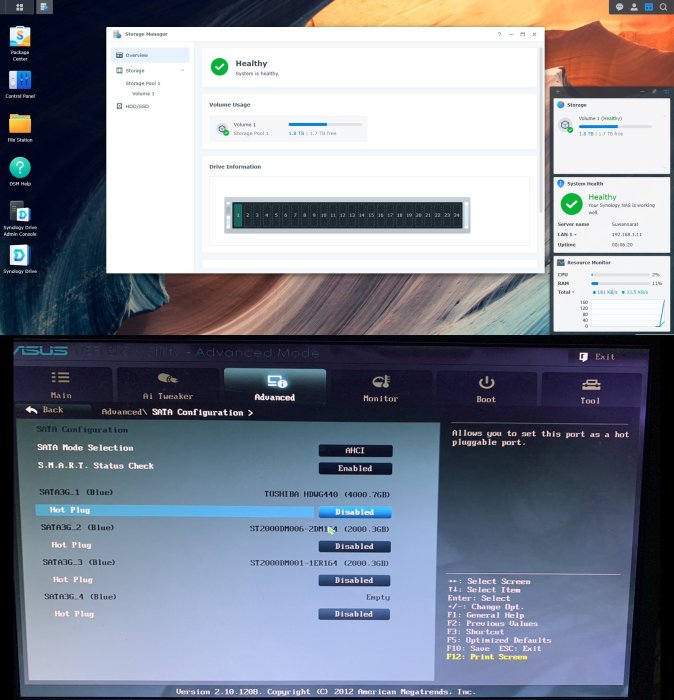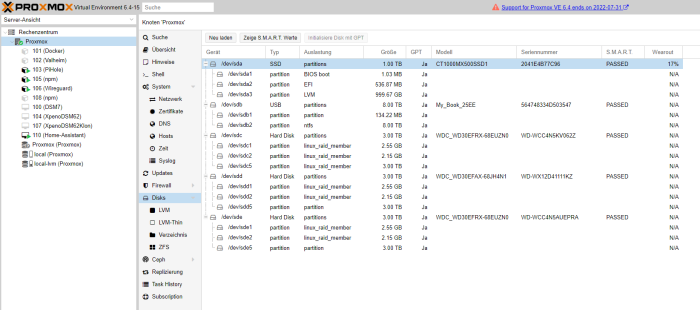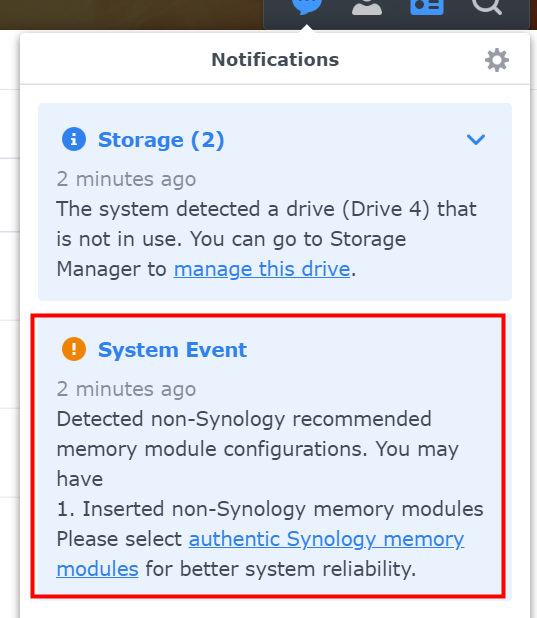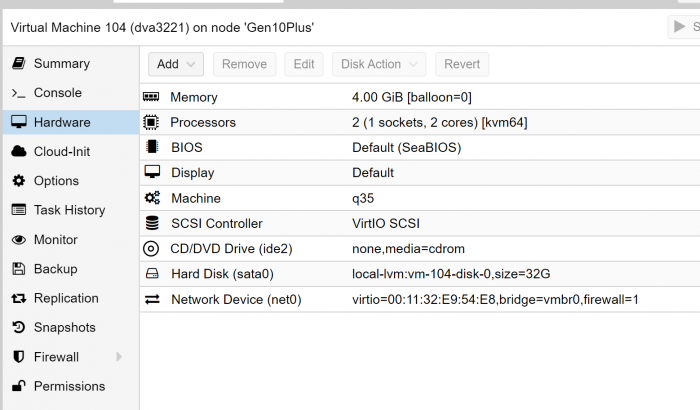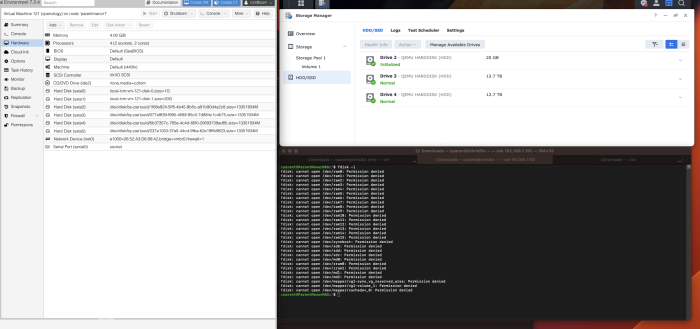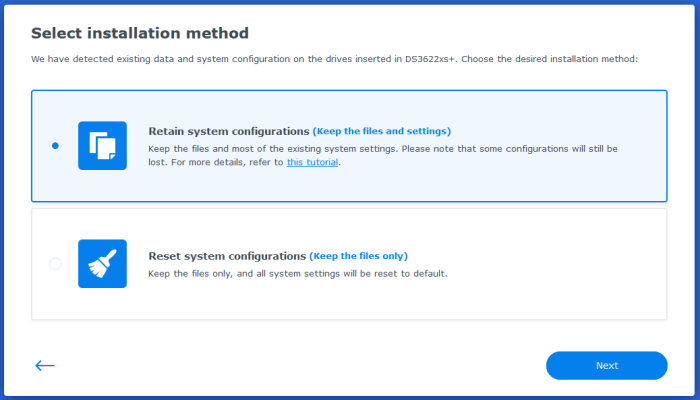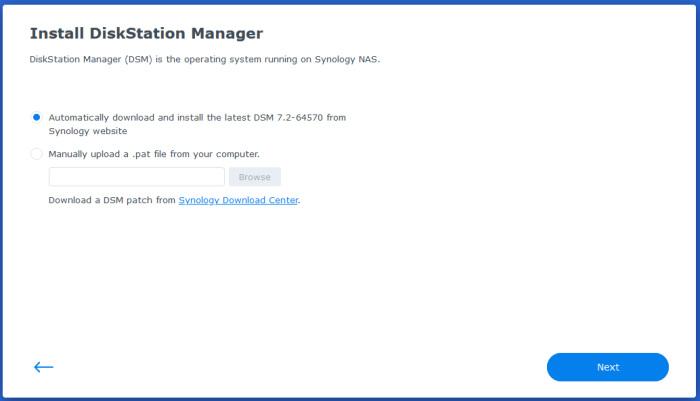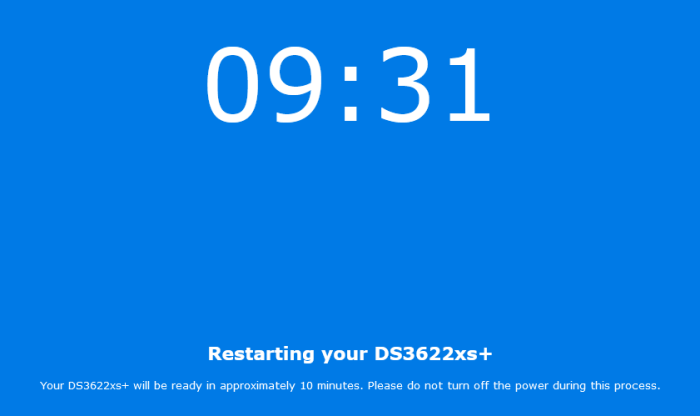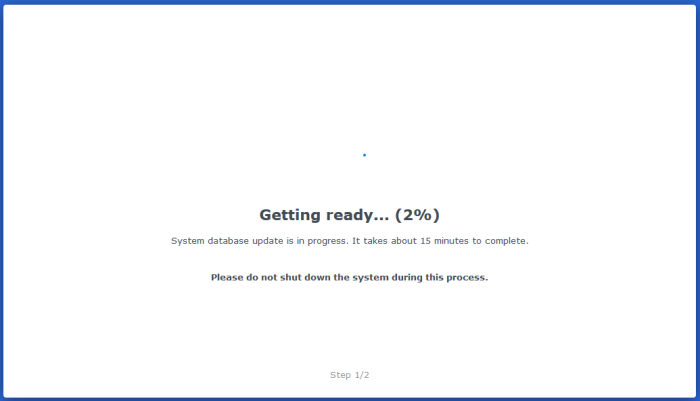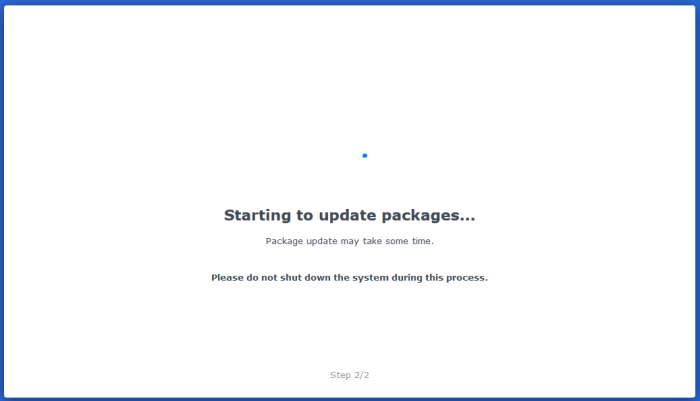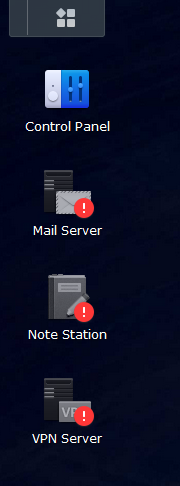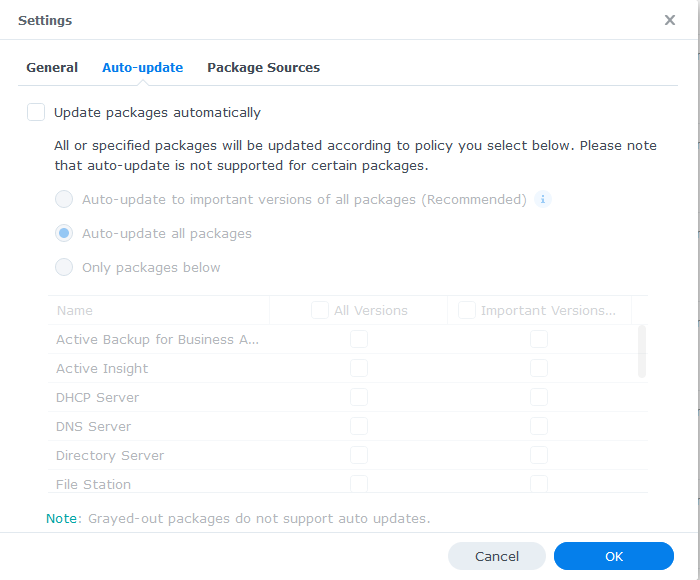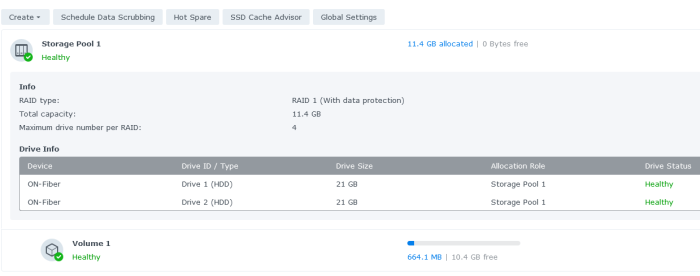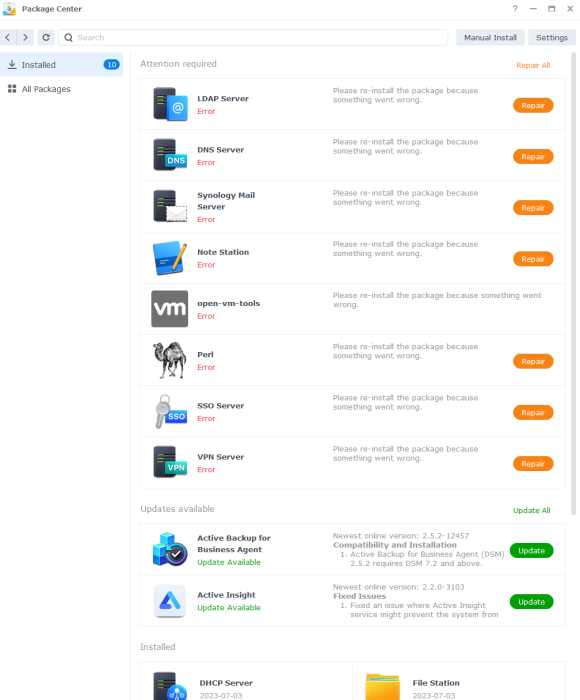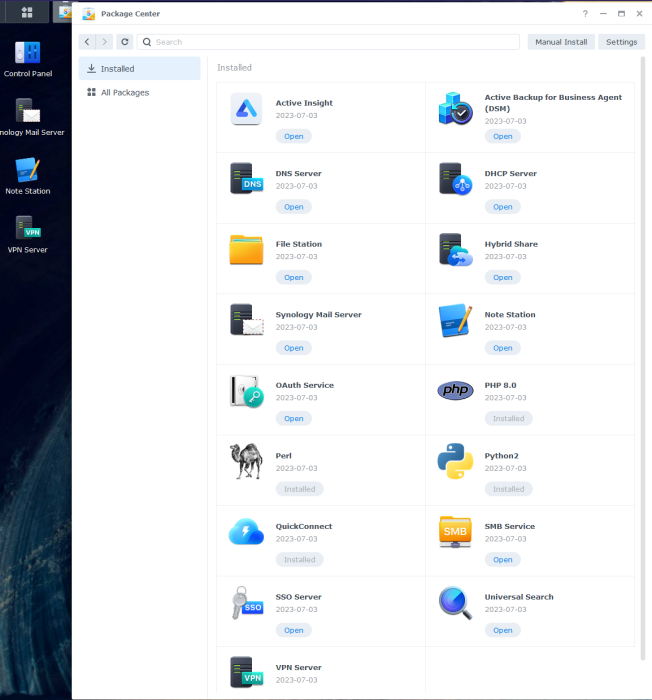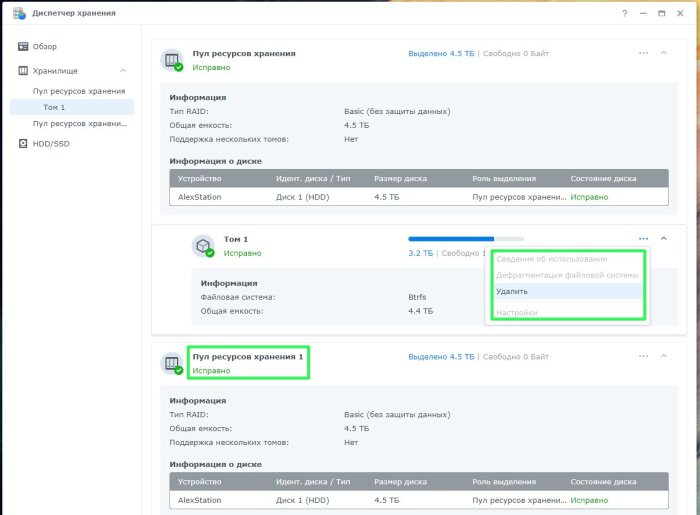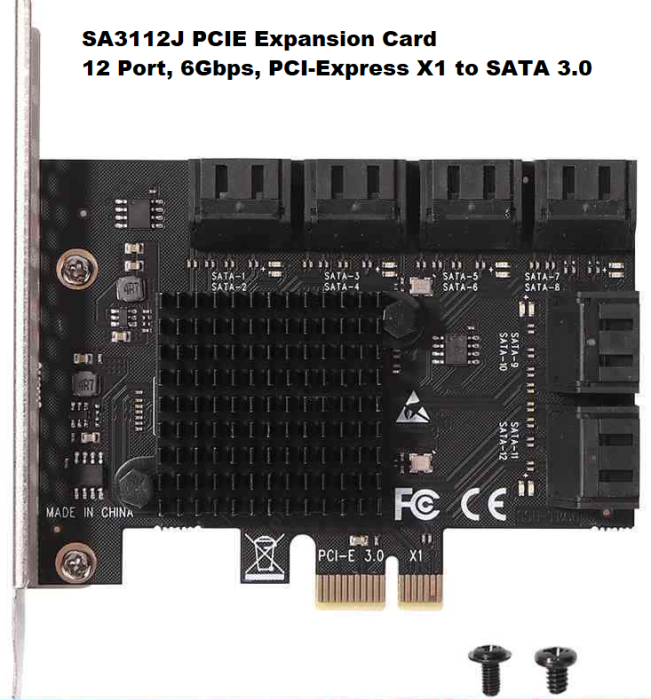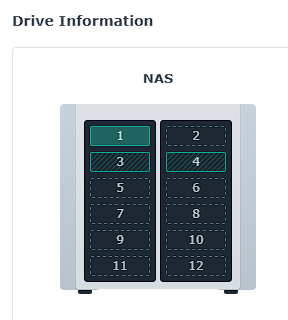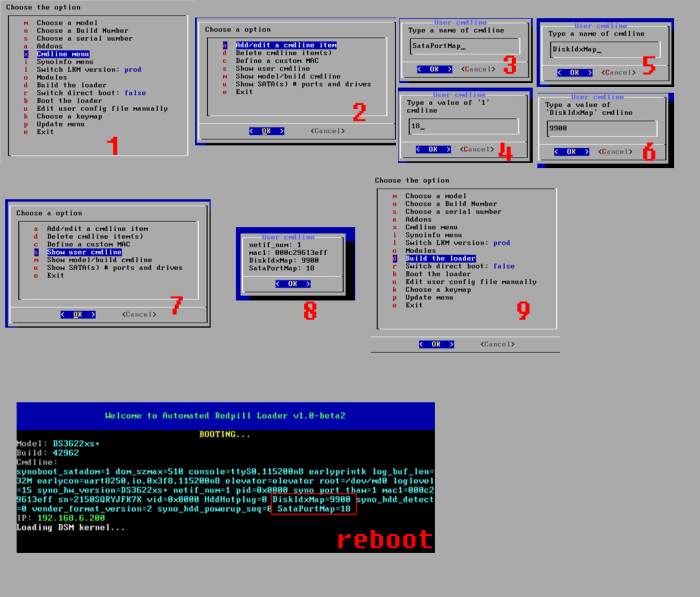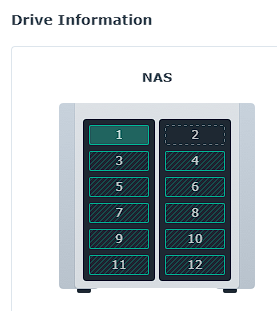Search the Community
Showing results for 'detected that the hard drives'.
-
I have old tower PC running baremetal DSM 7.x with an SHR storage pool and two volumes. I constantly hear the drives grinding away from where it sits across the room from me, but cannot figure out what is causing this activity. I've tried shutting down every docker container as well as any running package that I am able to stop, still the spinning continues. The noise is a little annoying but not unbearable, but I am mainly concerned with premature drive failure if these drives are constantly reading/writing 24/7. How to I figure out what the culprit is? Task manager doesn't seem to show a level of activity comparable to the constant grind I am hearing.
-
Is there a maximum number of drives DS918+ can detect?
rafoloru posted a question in General Questions
Hi, I'm building a new NAS with arpl-i18n and everythings goes well, except that I want to add 8 drives but the system only detect 6 of them (yes the two drive's works, I took them from an old Synology setup ) - I have 4 integrated SATA port on my motherboard and I added a PCI-e card of 4 additional SATA port. - My SATA PCI-e card (https://www.amazon.ca/-/fr/gp/product/B07T66ZXMT/ref=ppx_yo_dt_b_search_asin_title?ie=UTF8&psc=1) - DSM 7.2-64570 Update 1 Is there a limit the DS918+ can detect? Thanks -
I have an R720xd running RS4021 using Arpl-i18n-27.3.4 and flashed the H710 mini into IT mode using Fohdeesha's helpful process. Server bios doesn't recognize presence of hard drives and neither does ARPL in the course of building the loader. So while DSM sees the drives, I haven't been able to use sata_remap to get them in a sensible order. Minor incovenience at worst. Does anyone know whether there is a module or driver that can be loaded in the course of ARPL building the loader that would enable it to enumerate the harddrives?
-
Hey there, it might be a silly question with a simple answer but it was years ago I lastly dealt with My 6.2 Xpenology. So any help is highly appreciated! Due to a new NAS Case (Jonsbo N2) I changed my HBA 4xSata (all 4 SATA ports recognized in DSM) to a HBA 6xSata (not all SATA ports recognized in DSM). Because of the connector orientation and additional ports, I had to change the HBA. I also upgraded to DSM 7.1.1 but already tried 6.2 and multiple different versions and reinstalls with no difference. Current Board: J5040-ITX Old HBA: Syba SI-PEX40064 4 Port SATA III New HBA: IOCREST PCIe gen3 x1 zu 6 Ports 6G SATA III Im running Xpenology in Proxmox and can verify that before the PCI passthrough, all attached drives are recognized under Proxmox even with the new HBA. PCI passthrough is properly configured and was/is still working with the old HBA. 3x WDC_WD30EFxxxx In DSM only one disk is recognized. I read, that SataPortMap and DiskIdxMap is a thing, but can't really understand how that could be something in my particular problem. Any Luck with getting the new SATA HBA with 6 properly working ports in DSM configured? Or do I need just to get another one instead, or stick to the old one? But then I would've just had 2 ports due to the new case. Thanks in advance!
-
Recently migrated DVA3221 from esxi platform to PVE platform, everything is perfect, except after entering dsm desktop prompt: "Detected non-synology recommended memory module configuration". ProxmoxVE: Ver7.2-1, my hardware configuration is as shown in the figure, I have tried to reinstall with various parameters, when the installation is completed with the dsm system and the storage space is created, and then reboot into the DVA3221 desktop again, I will definitely get this prompt: "Detected Memory module configuration not recommended by Synology” After various tests, it was found that: 1. Whether compiling with arpl v1.0-beta2 or compiling with tinycore-redpill.v0.9.2.9.img, this problem will definitely occur as long as the model is DVA3221 2. dva3221 is perfect under the esxi platform, there will be no such incompatibility prompt 3. I have tried other models, such as DS3622xs+, the same hardware settings will not have problems.
-
Hi. I'm new to NAS/XPEnology. I'm running XPE in a VM on proxmox (7.2-4) using TRP 7.1.1-42962 with a DS3622xs+ config. I'm moving data over from an old snapraid setup, so most drives are not empty. I have 12 drives (14TB WD Red). My boot drive is 20GB. I have 2 14TB drives working in a JBOD pool, where the boot drive and the 2 storage drives are all listed as SATA. Eventually I'll convert it to a RAID5 once I get enough drives over that I have a spare. I rsync'd 2 drives over. That went well. Everything seems fine. I can see the data on the NAS. I told proxmox to send the 2 drives previously rsync'd from the Snapraid VM, to the XPE VM. I stopped the XPE VM and restarted it. The new drives are not showing up in the GUI or when I ssh in and look in /dev or fdisk -l. I ran "./rploader satamap now". It saw the 2 drives and updated the config. What could be wrong?
-
Hello, I just succeed to install my Xpenology using TCRP on ESXI 6.7 (due to hardware limitation, my SAS card isn't supported by ESXI 7+), using my raw disks directly into DSM (2 disks RAID managed by DSM, 2 disk in basic mode). I tried to activate the hibernation to the unused disks from DSM, but without success, and since the firmwares of the disks are generated by ESXI, I'm looking if I have something to manage on the ESXI interface to allow the disks to sleep... Thanks!!
-
Good Day, I've done some searching and can't seem to find an answer on my issue. I have a bare metal that I upgraded/migrated from DSM 6.2. I am using Redpill TinyCore. UEFI boot. I have 6x SATA drives plugged into the onboard Intel controller, and 8x SATA drives plugged into a LSI 9211-8i HBA. This setup worked fine on DSM 6.2 918+ Jun ./rploader.sh satamap detects the onboard SATA, and my HBA, but wants to use: SataPortMap=6 I've tried to change this manually to SataPortMap=68 and DiskIdxMap=0006, but this doesn't help even after recompiling. I've even tried removing statportmap and diskidxmap. I was able to get the 6x drives to detect, and DSM 7.2 is running. What am I missing to get the other 8x SATA drives detected on my HBA? Also tried to add the
-
Just documenting this for reference, in case anyone was pondering if it can be done. So my starting device was XPEnology DS3615xs running DSM 5.x migrating to XPEnology DS3622xs+ DSM 7.2.0 I practice first on a VM machine, then did it on an actual bare bones metal machine. If you are migrating VMs, make sure the new disk sizes are at least 21 GB, otherwise they'll fail to install DSM. I found out the hard way Scanned with Synology Assistant, it showed up as per screencap. Connected and I was presented with the expected page. Then you get these 2 choices, I left it as default to keep as much settings as possible from the old setup. Then you get this page, I used a downloaded DSM_DS3622xs+_64570.pat file as it's faster. After it's done wait for the machine to reboot. updating part 1 updating part 2 logged in, and found what I was trying to verify, it seems like it did not automatically install the packages I was using. well this kind of makes sense, it was not enabled. Data wise looks good, it kept all my old files as expected and drive config. Very neat, it automatically offered to Repair and Update Old packages, however as obsolete package will need to be uninstalled manually like the Open-VM-Tools After a short little while all Done! Note: the only configuration that got lost was the LDAP, which I had to undo, then rejoin again to register it to the LDAP, from the security point of view it makes sense, as it's technically a new machine joining the network, even thought it was an upgrade. My certificates, and most other settings remains intact.
-
Hi I am using Dell r510 as my device. With DSM 6.2.4 with jun loader ds 3618 xs , the main problem is that the lan or Ethernet port are not picking up by the system I was using next cloud on unraid previously on system the lan port was picking up fin The same problem accord when I use redpill to run Nas
-
HI All I have searched and cand find a working solution to this Using the 1.1beta 2a (latest) ARPL I have an HP Z420 xeon workstation, it has 8 on board sata ports, and ARPL only seems to see 3 as having disks connected. I also put all disks on a cheap and dirty 8 port pcie to sata card and again it only sees 3 hard disks, is this a current limitation or am I missing something thanks Cliff
-
I should know this as I have built several xpenology boxes but not sure on this. I have one server that I am going to replace all drives with larger ones. I have already removed all the files. After I replace with 4 new drives do I have to do anything with the flash drive or just replace the drives and when I boot I will just be setting up server again. Hope that makes sense. Thanks in advance.
-
Hello, I installed xpnology using tinycore-redpill based on DS3622xs+ today and I do not see all of my drives. I have updated to DSM 7.1.1-42962 Update 1 My server's motherboard is an Asus P9D-C/4l and I have an LSI 9211-4i (aka) SAS2004-IT with a SAS Expander card (RES2SV240). Motherboard has 1 SSD connected to port 1 and the LSI has 9 HDDS connected. All of the HDDS are connected to the SAS Expander Directly with 3x mini SAS to 4x SATA cables. LSI -> SAS EXPANDER -> 3x mini sas cables to sata 4x plugs -> 9x hdds. DSM Disk Manager is only showing 7 of the 9 HDDS and it is showing the single SSD. I have confirmed at boot time all of the HDDs are showing up and they also show using Gparted. Any help would be greatly appreciated!
-
Hi, Fellows at the moment I have DSM installed on a hp T620 and I am satisfied, but I would like to eventually plug in 4 2.5" drives. I found information that this is possible https://forum.openmediavault.org/index.php?thread/39956-pci-express-sata-card-on-hp-t620-thin-client/ Will DSM support this hardware properly ? If I plug in 4x 1TB can I get a 2TB miror ? Thank you for your answer.
-
I have DSM 6.2.3 U3 running on Jun's bootloader on ESXi 7.0 U3 with hard drives passed through using RDM. One of them reported as crashed earlier today. Fortunately, I have a backup but would like to get this server up and running again. I tried deleting the storage pool in DSM and re-adding it but it still shows crashed. I looked at the drive using ESXI SMART and got this: Parameter Value Threshold Worst Raw --------------------------------- ----- --------- ----- --- Health Status OK N/A N/A N/A Write Error Count 0 0 N/A 0 Read Error Count 251 51 N/A 251 Power-on Hours 34 0 34 130 Power Cycle Count 52 0 N/A 52 Reallocated Sector Count 0 140 N/A 0 Drive Temperature 32 0 N/A 32 Sector Reallocation Event Count 0 0 N/A 0 Pending Sector Reallocation Count 2 0 N/A 2 Uncorrectable Sector Count 0 0 N/A 0 Does the combination of the read error count and the pending sector reallocation count explain why DSM cannot use this hard drive? Anything else to try before I get and install a new hard drive?
-
Hello. Help solve the problem with the appearance of a new storage pool after a hard reboot (the lights went out). It cannot be deleted because both pools refer to the same volume. At the same time, volume maintenance cannot be performed (the menu is inactive). PS I created a similar topic in the Russian section of the forum, but no one answered there. Maybe we'll have better luck here.
-
Sorry if I posted in the wrong section! Hello everyone, Need your help, I have an old Dell OptiPlex 390 i5-2500 2nd Gen, 16GB of RAM and (2)x3TB drives, motherboard has 4 SATA ports, it’s a generic Dell motherboard very basic. I would like to install DSM 6/7 on it to use it for backup/cloud sync. I was following instructions for DS920+ and DS3622xs+ I was able to install it and get the IP address but I’m getting “No drives detected” message”. I believe that my sata ports are not being recognized correctly. Also, I did check BIOS for Hot Swap/Plug options it’s not available it’s a dell very basic BIOS. Can this computer be used or it’s not compatible? I will only be using (2) drives, so I don’t care which DS model I use as longest it works and stable. Additional details USB was made using tinycore-redpill.v0.9.3.0 ./rploader.sh Version : 0.9.3.0 tc@box:~$ ./rploader.sh satamap now Computed settings: SataPortMap=1 DiskIdxMap=00 tc@box:~$ lspci -tvnnq -[0000:00]-+-00.0 Intel Corporation 2nd Generation Core Processor Family DRAM Controller [8086:0100] +-02.0 Intel Corporation 2nd Generation Core Processor Family Integrated Graphics Controller [8086:0102] +-16.0 Intel Corporation 6 Series/C200 Series Chipset Family MEI Controller #1 [8086:1c3a] +-1a.0 Intel Corporation 6 Series/C200 Series Chipset Family USB Enhanced Host Controller #2 [8086:1c2d] +-1b.0 Intel Corporation 6 Series/C200 Series Chipset Family High Definition Audio Controller [8086:1c20] +-1c.0-[01]-- +-1c.2-[02]-- +-1c.4-[03]----00.0 Realtek Semiconductor Co., Ltd. RTL8111/8168/8411 PCI Express Gigabit Ethernet Controller [10ec:8168] +-1d.0 Intel Corporation 6 Series/C200 Series Chipset Family USB Enhanced Host Controller #1 [8086:1c26] +-1f.0 Intel Corporation H61 Express Chipset Family LPC Controller [8086:1c5c] +-1f.2 Intel Corporation 6 Series/C200 Series Chipset Family 4 port SATA IDE Controller [8086:1c00] +-1f.3 Intel Corporation 6 Series/C200 Series Chipset Family SMBus Controller [8086:1c22] \-1f.5 Intel Corporation 6 Series/C200 Series Chipset Family 2 port SATA IDE Controller [8086:1c08] Running: fdisk -l Disk /dev/sda: 2.73 TiB, 3000592982016 bytes, 5860533168 sectors Disk model: WDC WD30EFRX-68E Units: sectors of 1 * 512 = 512 bytes Sector size (logical/physical): 512 bytes / 4096 bytes I/O size (minimum/optimal): 4096 bytes / 4096 bytes Disklabel type: gpt Disk identifier: 7B499F80-44E5-4B50-A4F5-B58AD126E439 Device Start End Sectors Size Type /dev/sda1 128 4194304 4194177 2G Linux swap /dev/sda2 4194432 5860533134 5856338703 2.7T Solaris /usr & Apple ZFS Disk /dev/sdb: 2.73 TiB, 3000592982016 bytes, 5860533168 sectors Disk model: WDC WD30EZRX-00M Units: sectors of 1 * 512 = 512 bytes Sector size (logical/physical): 512 bytes / 4096 bytes I/O size (minimum/optimal): 4096 bytes / 4096 bytes Disklabel type: gpt Disk identifier: 9EDFA53C-F5D8-4D99-A218-49D24B42D473 Device Start End Sectors Size Type /dev/sdb1 128 4194304 4194177 2G Linux swap /dev/sdb2 4194432 5860533134 5856338703 2.7T Solaris /usr & Apple ZFS Big thank you to the developers this great!!
-
Sorry if I posted in the wrong section! Hello everyone, Need your help, I have an old Dell OptiPlex 390 i5-2500 2nd Gen, 16GB of RAM and (2)x3TB drives, motherboard has 4 SATA ports, it’s a generic Dell motherboard very basic. I would like to install DSM 6/7 on it to use it for backup/cloud sync. I was following instructions for DS920+ and DS3622xs+ I was able to install it and get the IP address but I’m getting “No drives detected” message”. I believe that my sata ports are not being recognized correctly. Also, I did check BIOS for Hot Swap/Plug options it’s not available it’s a dell very basic BIOS. Can this computer be used or it’s not compatible? I will only be using (2) drives, so I don’t care which DS model I use as longest it works and stable. Additional details USB was made using tinycore-redpill.v0.9.3.0 ./rploader.sh Version : 0.9.3.0 tc@box:~$ ./rploader.sh satamap now Computed settings: SataPortMap=1 DiskIdxMap=00 tc@box:~$ lspci -tvnnq -[0000:00]-+-00.0 Intel Corporation 2nd Generation Core Processor Family DRAM Controller [8086:0100] +-02.0 Intel Corporation 2nd Generation Core Processor Family Integrated Graphics Controller [8086:0102] +-16.0 Intel Corporation 6 Series/C200 Series Chipset Family MEI Controller #1 [8086:1c3a] +-1a.0 Intel Corporation 6 Series/C200 Series Chipset Family USB Enhanced Host Controller #2 [8086:1c2d] +-1b.0 Intel Corporation 6 Series/C200 Series Chipset Family High Definition Audio Controller [8086:1c20] +-1c.0-[01]-- +-1c.2-[02]-- +-1c.4-[03]----00.0 Realtek Semiconductor Co., Ltd. RTL8111/8168/8411 PCI Express Gigabit Ethernet Controller [10ec:8168] +-1d.0 Intel Corporation 6 Series/C200 Series Chipset Family USB Enhanced Host Controller #1 [8086:1c26] +-1f.0 Intel Corporation H61 Express Chipset Family LPC Controller [8086:1c5c] +-1f.2 Intel Corporation 6 Series/C200 Series Chipset Family 4 port SATA IDE Controller [8086:1c00] +-1f.3 Intel Corporation 6 Series/C200 Series Chipset Family SMBus Controller [8086:1c22] \-1f.5 Intel Corporation 6 Series/C200 Series Chipset Family 2 port SATA IDE Controller [8086:1c08] Running: fdisk -l Disk /dev/sda: 2.73 TiB, 3000592982016 bytes, 5860533168 sectors Disk model: WDC WD30EFRX-68E Units: sectors of 1 * 512 = 512 bytes Sector size (logical/physical): 512 bytes / 4096 bytes I/O size (minimum/optimal): 4096 bytes / 4096 bytes Disklabel type: gpt Disk identifier: 7B499F80-44E5-4B50-A4F5-B58AD126E439 Device Start End Sectors Size Type /dev/sda1 128 4194304 4194177 2G Linux swap /dev/sda2 4194432 5860533134 5856338703 2.7T Solaris /usr & Apple ZFS Disk /dev/sdb: 2.73 TiB, 3000592982016 bytes, 5860533168 sectors Disk model: WDC WD30EZRX-00M Units: sectors of 1 * 512 = 512 bytes Sector size (logical/physical): 512 bytes / 4096 bytes I/O size (minimum/optimal): 4096 bytes / 4096 bytes Disklabel type: gpt Disk identifier: 9EDFA53C-F5D8-4D99-A218-49D24B42D473 Device Start End Sectors Size Type /dev/sdb1 128 4194304 4194177 2G Linux swap /dev/sdb2 4194432 5860533134 5856338703 2.7T Solaris /usr & Apple ZFS Big thank you to the developers this great!!
-
hi guys, i'm new to community and xpenology, i've this hardware a supermicro 24bays with 2 ironwolf 4tb in raid1 almost full, i've bought another 2x4tb ironwolf hdd and installed in there, when i reboot the xpenology i can't found any of this two new hdd 1st. i've in there an old 500gb hdd and i remove it for dismiss it and in the same bay i've put 1 of the newest hdd and not work, after reboot i don't see any new drive, i've tried to put again the old 500gb and xpenology recognize it 2nd. all the sata cable are connected well, i've checked a lot of times 3rd. i know that xpenology run thanks to a loader in a usb and i see it that but i've no idea on how to boot into bios for see if the newest are recognozied by the mobo(i don't made this installation and i can't dismiss tth 4th. im on DS3617xs - DSM 6.2-23739 5th. suggest?
-
I was in the process of upgrading my DSM 6.2 NAS with 2 TB drives to DSM 7.1 using 16 TB drives. I figured that my SAS card was not compatible with drives that size and I needed to have 12 ports. I also learned that DSM 6 was not capable of properly handling large drives. I got me one of these: It was plug and play. It was immediately recognized by my system and ARPL. However, I noticed a problem with it. ARPL reported the 12 ports not contiguously used. It reported ports 1-4, and 17-24 as the ports assigned to the actual physical ports. I am a bit anal with things like this. I need the ports in the DSM Interface to match the actual ports of my drives in case I need to replace them. I even noticed that some of the assigned ports didn't even follow the proper order. I would have expected all the ports to be contiguous using the sequential numbers. So here's how I fixed it: Step 1. Identify which SATA port is mapped to which physical port 1. I plugged a drive to every physical port 2. I made a list of all the Serial Numbers of each disk and their physical location 3. Loaded DSM and checked in the Storage Manager > HDDs to identify the port actually assigned to each disk I ended up with the following list: SATA PHYSICAL 1 1 2 2 3 3 4 8 5 4 6 5 7 6 8 7 9 9 10 10 11 11 12 12 This helped me identify which ports I needed to switch in order for it to be shown contiguously with the proper numbers that correspond to the actual physical ports. Step 2. Rebuild the ARPL loader 1. I restarted the NAS and made sure to use the option to make changes to the loader 2. Went into the Command Line options by following this: 3. Added the following as the sata_remap command line option: sata_remap: 16>3:17>4:18>5:19>6:3>7:20>8:21>9:22>10:23>11 This translates to: Make port 16 be port 3. Make port 17 be port 4. Make port 18 be port 5. Make port 19 be port 6. Make port 3 be port 7. Make port 20 be port 8. Make port 21 be port 9. Make port 22 be port 10. Make port 23 be port 11. ---- NOTE THAT: The SATA ports are given values that start at 0. So, if I had 24 ports, it actually meant ports values were 0-23. That means that 16>3 is actually changing the DSM reported Drive 17 to be the Drive 4. ---- 4. Built the loader 5. Booted the loader Step 3. Confirm Changes After booting, I checked the reported drives and their serials and that they matched the order in which the physical ports were put. Hope you find this useful.
-
Hi all! I'm new to DSM7 and Redpill, coming from XPE 6.2.2. I've got it working on ESXi 6.5, HP DL380p G8. However, I see only 8 of my 10 drives. I'm using RDM and virtual SATA (was using iSCSI with 6.2.2). I've read about the sataportmap and tried setting it to the correct values, but can't ever get passed the 8 disk limit. Also, while Synology sees 8 drives in the Drive Manager, it says that the 12 disk bays are empty. What logs/configs do you need? Again, I'm new here. Thank you!
-
Hi Everyone, I have a huge problem and I'm hoping to solve (or at least mitigate it) it with your help. Here's my apocalyptic scenario: Until last week I had a fully working XPenology DSM 7.1 3622xs+ on BareMetal installed via Tiny Core RedPill. For unknown reasons, after another power break, the DSM web interface breaks resulting in a no longer accessible page. The OS is still there, the loader still works and loads the system, making it visible even via the Synology Assistant but there's no way to get to the interface again. I tried to reinstallthe DSM, hoping for the installer to see the disks with already present data but they looked like "new" to the installer. Installation failed systematically at 55%. I rebuilt the tinycore pendrive and reinstalled. This time the installation arrived to its end but (even after the usual 10 minutes to wait for the system to reboot) for some unknown reason the server wasn't available. This time not even the Synology Assistant could see it anymore. At this point, my only objective has become to "just" recover the data so - while panic starts to rise - I started researching: my system was running 4x4TB units (WD Red) configured in RAID0 for a total available space of about 8TB with BTRFS filesystem so basically data has to be recovered from 2 of the 4 physical drives. I saw there's a driver allowing Windows to see BTRFS and I installed it on my laptop so I took the disks out of my XPenology build and plugged them into my drive docking station connected to one of my Windows Laptops. Disks are seen by the OS's disk utility but not accessible. They result as "not formatted". I tried then to use Paragon Partition Manager, hoping to get to access the disks' content. No progress. Then I installed a BTRFS data recovery utility (on Windows) for damaged drives and while it started scanning one of the drives it started finding some "familiar" stuff. I am now literally stuck into deciding whether to give up and say forever goodbye to my data or to keep fighting what in the end could still be a losing game but I am a fighter. My next step would be to try to access the drives with a Linux (instead of a Windows) machine, which should support BTRFS, but maybe some of you has some experience already thus I ask the question "is it worth trying?" Also I wonder, on top of all this, if maybe there is a way to make everything "visible" if I firstly install a new XPenology DSM 7.1 3622xs+ on the same machine with a separate empty drive and then I start connecting the disks once I get this new system fully up and running. Has anyone of you experienced a similar issue and found a solution? If yes, how did that happen? I do not have other ideas about how to solve this problem so I'm open to any possible constructive advice. Thanks a lot in advance just for the patience to read this post!
-
Anyone else seen this problem? Everything working fine until yesterday. I had a small SSD drive (drive 5) which I used as volume 1. Volume 2 has 4 x 1GB Western Digital Drives all showing as healthy. Drive 5 (Volume 1) has disappeared with the log entry of the title. I am unable to access Volume 2. Changed drive 5 (Volume 1) for another perfectly working SSD. Only to see the same problem with the same log entry. Any ideas?
-
Hardware: SUPERMICRO X10SDV-TLN4F D-1541 (2 x 10 GbE LAN & 2 x Intel i350-AM2 GbE LAN) LSI HBA with 8 HDDs (onboard STA controllers disabled) Previous attempts using TCRP & broadwellnk failed because I couldn't get a network connection (may be related to 10g NICs) Using TCRP & broadwell gets me further because the device is now discoverable in Synology Assistant, however, I keep getting "no drives" found. SataPortMap=8 DiskIdxMap=00 and SataPortMap=1 DiskIdxMap=00 tc@box:~$ ls -la /sys/class/ata_port total 0 tc@box:~$ lspci -tvnnq -+-[0000:ff]-+-0b.0 Intel Corporation Xeon E7 v4/Xeon E5 v4/Xeon E3 v4/Xeon D R3 QPI Link 0/1 [8086:6f81] | +-0b.1 Intel Corporation Xeon E7 v4/Xeon E5 v4/Xeon E3 v4/Xeon D R3 QPI Link 0/1 [8086:6f36] | +-0b.2 Intel Corporation Xeon E7 v4/Xeon E5 v4/Xeon E3 v4/Xeon D R3 QPI Link 0/1 [8086:6f37] | +-0b.3 Intel Corporation Xeon E7 v4/Xeon E5 v4/Xeon E3 v4/Xeon D R3 QPI Link Debug [8086:6f76] | +-0c.0 Intel Corporation Xeon E7 v4/Xeon E5 v4/Xeon E3 v4/Xeon D Caching Agent [8086:6fe0] | +-0c.1 Intel Corporation Xeon E7 v4/Xeon E5 v4/Xeon E3 v4/Xeon D Caching Agent [8086:6fe1] | +-0c.2 Intel Corporation Xeon E7 v4/Xeon E5 v4/Xeon E3 v4/Xeon D Caching Agent [8086:6fe2] | +-0c.3 Intel Corporation Xeon E7 v4/Xeon E5 v4/Xeon E3 v4/Xeon D Caching Agent [8086:6fe3] | +-0c.4 Intel Corporation Xeon E7 v4/Xeon E5 v4/Xeon E3 v4/Xeon D Caching Agent [8086:6fe4] | +-0c.5 Intel Corporation Xeon E7 v4/Xeon E5 v4/Xeon E3 v4/Xeon D Caching Agent [8086:6fe5] | +-0c.6 Intel Corporation Xeon E7 v4/Xeon E5 v4/Xeon E3 v4/Xeon D Caching Agent [8086:6fe6] | +-0c.7 Intel Corporation Xeon E7 v4/Xeon E5 v4/Xeon E3 v4/Xeon D Caching Agent [8086:6fe7] | +-0f.0 Intel Corporation Xeon E7 v4/Xeon E5 v4/Xeon E3 v4/Xeon D Caching Agent [8086:6ff8] | +-0f.4 Intel Corporation Xeon E7 v4/Xeon E5 v4/Xeon E3 v4/Xeon D Caching Agent [8086:6ffc] | +-0f.5 Intel Corporation Xeon E7 v4/Xeon E5 v4/Xeon E3 v4/Xeon D Caching Agent [8086:6ffd] | +-0f.6 Intel Corporation Xeon E7 v4/Xeon E5 v4/Xeon E3 v4/Xeon D Caching Agent [8086:6ffe] | +-10.0 Intel Corporation Xeon E7 v4/Xeon E5 v4/Xeon E3 v4/Xeon D R2PCIe Agent [8086:6f1d] | +-10.1 Intel Corporation Xeon E7 v4/Xeon E5 v4/Xeon E3 v4/Xeon D R2PCIe Agent [8086:6f34] | +-10.5 Intel Corporation Xeon E7 v4/Xeon E5 v4/Xeon E3 v4/Xeon D Ubox [8086:6f1e] | +-10.6 Intel Corporation Xeon E7 v4/Xeon E5 v4/Xeon E3 v4/Xeon D Ubox [8086:6f7d] | +-10.7 Intel Corporation Xeon E7 v4/Xeon E5 v4/Xeon E3 v4/Xeon D Ubox [8086:6f1f] | +-12.0 Intel Corporation Xeon E7 v4/Xeon E5 v4/Xeon E3 v4/Xeon D Home Agent 0 [8086:6fa0] | +-12.1 Intel Corporation Xeon E7 v4/Xeon E5 v4/Xeon E3 v4/Xeon D Home Agent 0 [8086:6f30] | +-13.0 Intel Corporation Xeon E7 v4/Xeon E5 v4/Xeon E3 v4/Xeon D Memory Controller 0 - Target Address/Thermal/RAS [8086:6fa8] | +-13.1 Intel Corporation Xeon E7 v4/Xeon E5 v4/Xeon E3 v4/Xeon D Memory Controller 0 - Target Address/Thermal/RAS [8086:6f71] | +-13.2 Intel Corporation Xeon E7 v4/Xeon E5 v4/Xeon E3 v4/Xeon D Memory Controller 0 - Channel Target Address Decoder [8086:6faa] | +-13.3 Intel Corporation Xeon E7 v4/Xeon E5 v4/Xeon E3 v4/Xeon D Memory Controller 0 - Channel Target Address Decoder [8086:6fab] | +-13.4 Intel Corporation Xeon E7 v4/Xeon E5 v4/Xeon E3 v4/Xeon D Memory Controller 0 - Channel Target Address Decoder [8086:6fac] | +-13.5 Intel Corporation Xeon E7 v4/Xeon E5 v4/Xeon E3 v4/Xeon D Memory Controller 0 - Channel Target Address Decoder [8086:6fad] | +-13.6 Intel Corporation Xeon E7 v4/Xeon E5 v4/Xeon E3 v4/Xeon D DDRIO Channel 0/1 Broadcast [8086:6fae] | +-13.7 Intel Corporation Xeon E7 v4/Xeon E5 v4/Xeon E3 v4/Xeon D DDRIO Global Broadcast [8086:6faf] | +-14.0 Intel Corporation Xeon E7 v4/Xeon E5 v4/Xeon E3 v4/Xeon D Memory Controller 0 - Channel 0 Thermal Control [8086:6fb0] | +-14.1 Intel Corporation Xeon E7 v4/Xeon E5 v4/Xeon E3 v4/Xeon D Memory Controller 0 - Channel 1 Thermal Control [8086:6fb1] | +-14.2 Intel Corporation Xeon E7 v4/Xeon E5 v4/Xeon E3 v4/Xeon D Memory Controller 0 - Channel 0 Error [8086:6fb2] | +-14.3 Intel Corporation Xeon E7 v4/Xeon E5 v4/Xeon E3 v4/Xeon D Memory Controller 0 - Channel 1 Error [8086:6fb3] | +-14.4 Intel Corporation Xeon E7 v4/Xeon E5 v4/Xeon E3 v4/Xeon D DDRIO Channel 0/1 Interface [8086:6fbc] | +-14.5 Intel Corporation Xeon E7 v4/Xeon E5 v4/Xeon E3 v4/Xeon D DDRIO Channel 0/1 Interface [8086:6fbd] | +-14.6 Intel Corporation Xeon E7 v4/Xeon E5 v4/Xeon E3 v4/Xeon D DDRIO Channel 0/1 Interface [8086:6fbe] | +-14.7 Intel Corporation Xeon E7 v4/Xeon E5 v4/Xeon E3 v4/Xeon D DDRIO Channel 0/1 Interface [8086:6fbf] | +-15.0 Intel Corporation Xeon E7 v4/Xeon E5 v4/Xeon E3 v4/Xeon D Memory Controller 0 - Channel 2 Thermal Control [8086:6fb4] | +-15.1 Intel Corporation Xeon E7 v4/Xeon E5 v4/Xeon E3 v4/Xeon D Memory Controller 0 - Channel 3 Thermal Control [8086:6fb5] | +-15.2 Intel Corporation Xeon E7 v4/Xeon E5 v4/Xeon E3 v4/Xeon D Memory Controller 0 - Channel 2 Error [8086:6fb6] | +-15.3 Intel Corporation Xeon E7 v4/Xeon E5 v4/Xeon E3 v4/Xeon D Memory Controller 0 - Channel 3 Error [8086:6fb7] | +-1e.0 Intel Corporation Xeon E7 v4/Xeon E5 v4/Xeon E3 v4/Xeon D Power Control Unit [8086:6f98] | +-1e.1 Intel Corporation Xeon E7 v4/Xeon E5 v4/Xeon E3 v4/Xeon D Power Control Unit [8086:6f99] | +-1e.2 Intel Corporation Xeon E7 v4/Xeon E5 v4/Xeon E3 v4/Xeon D Power Control Unit [8086:6f9a] | +-1e.3 Intel Corporation Xeon E7 v4/Xeon E5 v4/Xeon E3 v4/Xeon D Power Control Unit [8086:6fc0] | +-1e.4 Intel Corporation Xeon E7 v4/Xeon E5 v4/Xeon E3 v4/Xeon D Power Control Unit [8086:6f9c] | +-1f.0 Intel Corporation Xeon E7 v4/Xeon E5 v4/Xeon E3 v4/Xeon D Power Control Unit [8086:6f88] | \-1f.2 Intel Corporation Xeon E7 v4/Xeon E5 v4/Xeon E3 v4/Xeon D Power Control Unit [8086:6f8a] \-[0000:00]-+-00.0 Intel Corporation Xeon E7 v4/Xeon E5 v4/Xeon E3 v4/Xeon D DMI2 [8086:6f00] +-01.0-[01]-- +-02.0-[02]--+-00.0 Intel Corporation Xeon Processor D Family QuickData Technology Register DMA Channel 0 [8086:6f50] | +-00.1 Intel Corporation Xeon Processor D Family QuickData Technology Register DMA Channel 1 [8086:6f51] | +-00.2 Intel Corporation Xeon Processor D Family QuickData Technology Register DMA Channel 2 [8086:6f52] | \-00.3 Intel Corporation Xeon Processor D Family QuickData Technology Register DMA Channel 3 [8086:6f53] +-02.2-[03]--+-00.0 Intel Corporation Ethernet Connection X552/X557-AT 10GBASE-T [8086:15ad] | \-00.1 Intel Corporation Ethernet Connection X552/X557-AT 10GBASE-T [8086:15ad] +-03.0-[04]----00.0 LSI Logic / Symbios Logic SAS2008 PCI-Express Fusion-MPT SAS-2 [Falcon] [1000:0072] +-05.0 Intel Corporation Xeon E7 v4/Xeon E5 v4/Xeon E3 v4/Xeon D Map/VTd_Misc/System Management [8086:6f28] +-05.1 Intel Corporation Xeon E7 v4/Xeon E5 v4/Xeon E3 v4/Xeon D IIO Hot Plug [8086:6f29] +-05.2 Intel Corporation Xeon E7 v4/Xeon E5 v4/Xeon E3 v4/Xeon D IIO RAS/Control Status/Global Errors [8086:6f2a] +-14.0 Intel Corporation 8 Series/C220 Series Chipset Family USB xHCI [8086:8c31] +-16.0 Intel Corporation 8 Series/C220 Series Chipset Family MEI Controller #1 [8086:8c3a] +-16.1 Intel Corporation 8 Series/C220 Series Chipset Family MEI Controller #2 [8086:8c3b] +-1a.0 Intel Corporation 8 Series/C220 Series Chipset Family USB EHCI #2 [8086:8c2d] +-1c.0-[05]--+-00.0 Intel Corporation I350 Gigabit Network Connection [8086:1521] | \-00.1 Intel Corporation I350 Gigabit Network Connection [8086:1521] +-1c.4-[06-07]----00.0-[07]----00.0 ASPEED Technology, Inc. ASPEED Graphics Family [1a03:2000] +-1d.0 Intel Corporation 8 Series/C220 Series Chipset Family USB EHCI #1 [8086:8c26] +-1f.0 Intel Corporation C224 Series Chipset Family Server Standard SKU LPC Controller [8086:8c54] +-1f.3 Intel Corporation 8 Series/C220 Series Chipset Family SMBus Controller [8086:8c22] \-1f.6 Intel Corporation 8 Series Chipset Family Thermal Management Controller [8086:8c24]
